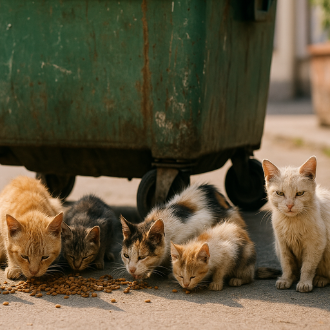The Importance of Spaying and Neutering: A Responsible Act for Animal Welfare
By Lost'Him Team • February 22, 2025

Spaying and neutering pets and stray animals are essential practices for their health, well-being, and the protection of wildlife. However, many pet owners still hesitate, often due to misinformation or concerns about potential side effects.
Beyond being a personal choice, sterilization is a responsible act that helps reduce overpopulation, limit abandonment, prevent escapes, and protect the health of our companions.
At Lost’Him, we believe that spaying and neutering are crucial preventive measures for harmonious coexistence between humans and animals and for better management of lost and found pets.
1. What Are the Differences Between Spaying and Neutering?
These terms are often used interchangeably, but they refer to different procedures:
- Spaying: A procedure that prevents an animal from reproducing while keeping its sex hormones.
- Neutering: The removal of reproductive organs (testicles in males, ovaries ± uterus in females).
👉 Common Methods:
- Ovariectomy (females): Removal of the ovaries.
- Ovariohysterectomy: Removal of the ovaries and uterus.
- Neutering (males): Removal of the testicles.
- Chemical sterilization: A temporary method, but less common.
💡 Neutering is generally preferred as it eliminates reproductive behaviors and improves the animal's health.
2. Health Benefits for Animals
👉 Prevention of Cancers and Hormonal Diseases
- For females:
- Reduces the risk of mammary tumors (up to 90% if performed before the first heat cycle).
- Eliminates the risk of serious uterine infections (pyometra).
- For males:
- Prevents testicular tumors and reduces the risk of prostate issues.
- Lower risk of anal and perianal tumors.
💡 A sterilized animal often lives longer and in better health.
👉 Reduction of Problematic Behaviors
- Less urine marking (especially in male cats and dogs).
- Reduced aggression and escape attempts.
- Decreased unwanted sexual behaviors (howling, mounting, fighting).
💡 A sterilized animal is often calmer and more balanced.
👉 Fewer Escapes and Accidents
- Unsterilized animals often try to escape to find mates.
- Lower risk of crossing roads, getting trapped, or being attacked by other animals.
💡 Spaying and neutering, along with identification, make it easier to find lost pets through Lost’Him.
3. A Crucial Act to Combat Overpopulation and Abandonment
👉 Alarming Statistics:
- A pair of unsterilized cats can produce up to 20,000 descendants in four years.
- Thousands of dogs are abandoned yearly due to unwanted litters.
- Rabbits and small pets experience uncontrolled population growth.
💡 Spaying and neutering are the only effective solutions to prevent unwanted births and reduce abandonment.
👉 Protecting Wildlife and the Environment
- Stray cats kill millions of birds and small mammals each year.
- Stray dogs can attack livestock or wildlife.
- Uncontrolled animal populations disrupt ecosystems.
💡 Controlling the reproduction of domestic animals helps protect biodiversity.
4. Legal Requirements and Regulations
In some countries, sterilization is legally required:
- 🇫🇷 France: Mandatory identification and sterilization for captured stray cats.
- 🇧🇪 Belgium: Mandatory sterilization for domestic cats.
- 🇮🇹 Italy: Government-funded sterilization programs.
- 🇪🇸 Spain: Some cities require sterilization to control stray populations.
💡 Check local regulations with your municipality or veterinarian.
5. Common Myths About Spaying and Neutering
👉 “My pet will become obese.”: FALSE
- Obesity depends on diet and physical activity.
- A balanced diet and regular play prevent weight gain.
👉 “My pet needs to have a litter first.”: FALSE
- There is no scientific benefit to allowing a female to breed before sterilization.
- In fact, early sterilization greatly reduces the risk of mammary tumors.
👉 “It’s unnatural.”: FALSE
- Domestic animals rely on us for their well-being.
- Uncontrolled reproduction leads to suffering and abandonment.
💡 Protecting your pet also means preventing uncontrolled reproduction.
Conclusion: Spaying and Neutering – An Act of Love and Responsibility
- ✅ Protects the animal’s health (reducing cancer and infection risks).
- ✅ Reduces risky behaviors (escapes, fights, marking).
- ✅ Combats overpopulation and abandonment.
- ✅ Follows legal regulations and promotes harmonious coexistence.
- ✅ Facilitates finding lost pets through Lost’Him.
💡 Spaying and neutering show love and provide long-term protection for our companions. 🐾💙
 EN
EN  FR
FR